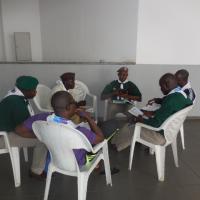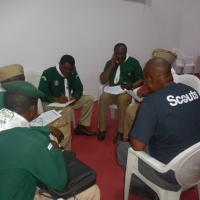
GSAT WORKSHOP CONDUCTED BY THE WORLD SCOUT BUREAU - AFRICA SUPPORT CENTER FOR THE SCOUT ASSOCIATION OF NIGERIA
1. The Genesis: The Scout Association of Nigeria with former names Boy Scout Association of Nigeria became member of the World Organization of Scout Movement (WOSM) in 1961 under the names International Scout Organization with her Headquarters then in Ottawa Canada. Though Scouting under the names Boy Scout of Nigeria started in Nigeria under the British Protectorates in 1915, with the then Governor Generals being the Chief Scout of Nigeria and various Regions operating under the Boy Scout of Nigeria Federal Act of Parliament of 1937, CAP 39, 1942, 1961, 1990 respectively. The World Scout Conference of 1999 wanted all National Scout Organization to be Gender Sensitive, based on one of her Resolutions at the Conference and requested all National Scout Organization to reflect Gender (men/women, boy/girl) inclusion in their operations. At the Boy Scout Association of Nigeria Annual General Meeting of 1999, The Conference agreed to change the names of the Association from: BOY SCOUT ASSOCIATION OF NIGERIA, into THE SCOUT ASSOCIATION OF NIGERIA.
The Scout Association of Nigeria, over the years has had series of major restructurings that were in-line with the Visions, Missions and Strategic Priorities of Scouting, in a bit to make the Association to continue to re-freshening her operations that is tailored towards better Scouting. Some of these were, but not limited to:
a. World Scout Committee – Sub-Committee Training Policy of 1961, 1965, 1969 and jettisoned in 1982
b. World Scout Committee 1999-2002 Vision of creating a better World via real contributions of Scouting, with a Mission of making young Scouts be responsible citizens not only for themselves, but to their local and International Communities through moulding of their Characters, Physically, Emotionally, Intellectually, and Spiritually; through the Seven Strategic Priorities that looked at: (1) Youth Involvement in Scouting (2) Adolescents (3) Gender Equalization in Scouting (4) Reaching Out (5) Adult in Scouting (6) 21st Century Organization in Scouting and (7) Scout Profile.
c. World Scout Committee 2014 Vision of developing 100 Million young Scouts by making them Agents of Positive Changes within their Communities by creating Impacts. This is to be achieved via same Mission of 1999-2002, with newer Strategies of: (1) Youth Engagement, (2) Educational Methods in Scouting, (3) Diversity and Inclusions, (4) Social Impacts (5) Communication and External Relations and (6) Governance.
All the newer aforementioned Strategies, Vision and Mission are expected to be deployed to all the 164 National Scout Organizations in which Nigeria National Scout Organization is One. At the end of the World Scout Conference in Ljubljana Slovenia in 2014, the new Strategic Priorities were deployed to all National Scout Committee members at her various National Executive Committee meetings and same to the National Scout Council at the 2015 Annual General Meeting at Oshogbo in Osun State. The NSO organization was restructured towards these newer Vision/Mission/Strategic Priorities. However, because “Change” is the most resisted thing in life, some of the NSO members were not happy or in alignment with the new restructuring thereby led to internal miss-understanding that dove tailed into calling for the Extra Ordinary General Meeting. Since the need to Restructuring all the 38 NSO that make up Africa Region was directed at the All Africa Scout Conference 2015 General Assembly meeting at Uganda. NSOs were to align with the Restructuring processes, so as to drive home the Vision and Mission of Scouting by 2023.
2. Preparations for the GSAT Workshop
Global Support Assessment Tool is a standard as deployed by World Organization of Scout Movement (WOSM) to qualify and benchmark all National Scout Organization to actually test the Standards being utilized by each and every National Scout Organization in the management of Scouting Organizations. See attached the Ten (10) Dimensions of Expectations as documented for qualifications.
There are Ten (10) Expectations namely:
1. NSO - WOSM INSTITUTIONAL REQUIREMENTS
In its Article VII (Chapter III), the WOSM Constitution outlines several obligations for Member Organizations such as (a) continued acceptance of and conformity with the requirements of the Constitution of the World Organization, (b) to make an annual report to the World Scout Bureau, (c) to get approval by the World Scout Committee prior to implementation of any changes to its national constitution. Besides formal requirements stated in the WOSM Constitution, there are several best practices that express full integration of an NSO into the World Scout Movement such as the NSO’s participation to World or Regional Conferences and Events, in-country legal registration, protection of the Scouting names, logos and brands, submission of financial audited reports etc.
2. GOVERNANCE FRAMEWORK
The National Board is the policy-making body of an NSO while the General Assembly would be its highest authority. The National Board exercises a leadership role and provides the strategic direction of the organization. This National Board ensures that the long term vision-mission, goals, and objectives of the organization are carried out by the management and staff. Being the main group of individuals that steers the organization, this Board must be composed of independent-minded persons acting in a voluntary capacity. They should possess certain qualifications that befit the organization’s principles and adhere to conflict of interest policies. Moreover, the Board should be governed by its own rules on conduct, attendance, meetings, quorum, voting rights, and terms of office.
3. STRATEGIC FRAMEWORK
This dimension deals with the NSO’s reason for being: its vision-mission statement, its existence, its consistency throughout the NSO’s operations, structure and processes, and how it projects itself to its beneficiaries and the public. It investigates and assesses the extent to which these governing principles are documented, adopted, embedded, and made consistent with the NSO’s governing documents, structure, and processes, and how clearly these are communicated to its stakeholders and publics.
4. INTEGRITY MANAGEMENT
This dimension addresses the organization’s ethical standards and practices, checks and balances, behavioural policies, and non-conformance processes and systems. Organizational policies, systems and procedures shall be pre-defined and documented so that staff from the top management down to the rank and file will be guided not only in the performance of their respective duties and responsibilities but more importantly in their conduct and behaviour.
5. COMMUNICATION, ADVOCACY & PUBLIC IMAGE
This dimension revolves around the communication policy of the organization to its various internal and external stakeholders, its grantors, its publics, and within its organization, particularly in relation to its operational undertakings, finances, stewardship, and the overall image it wishes to build and project .The overall purpose is here to assess the policy of transparency and how the organization keeps the public and its stakeholders apprised of its operations. Areas covered are the system and policy of reporting, the organizational goals and accomplishments, the use of resources to achieve these goals, and the promotional materials.
6. ADULTS IN SCOUTING
This dimension deals with how the NSO handles human resources related matters such as recruitment, hiring, training, performance management, compensation and benefits, security, and employees’ relations. No matter how well-crafted the NSO’s policies, procedures, and programs may be these cannot be implemented without the right people (as long as they are supported to better cope with the changing conditions in their associations and countries). It is therefore critical to the NSO’ success, and sustainability that the right people are chosen for each position, that their performance is properly monitored and assessed, and that they are adequately compensated for their efforts and outputs. As per the Adults in Scouting World Policy, when referring to Adults, we refer to professionals - paid staff - and volunteers.
7. RESOURCE ALLOCATION & FINANCIAL CONTROLS
This dimension focuses on financial policies, resource generation and allocation, and financial controls. The objective is to determine the organization's levels of financial accountability and transparency. This is done through an examination and measurement of the organization's financial systems and processes in place (or lack of) and identification of areas of improvement to address the weak aspects of the financial system.
8. YOUTH PROGRAMME
This dimension deals with the NSO’s “raison d’être”: from planning its major thrusts and objectives to detailing its mode of operations at the program, project, and field levels. NSOs need to operate on certain planning, implementation, monitoring, and evaluation and feedback adjustment systems. Each of these systems is essential in carrying out the NSO’s objectives and key performance indicators from the planning stage (at the “drawing table”) down to the project or field level activities.
9. GROWTH POTENTIAL
This Dimension expresses the need for nonprofits in general to make tremendous efforts even to keep their current levels of service and funding. Those NSOs that grow are likely to do something proactively (otherwise, “competition” is likely to dent into their “market share”). Several factors are critical to a nonprofit’s ability to grow among which: Preparing for growth, demonstrating results, marketing to specific funders and engaging board members’ time, talent and resources.
10. CONTINUOUS IMPROVEMENT
This last Dimension of GSAT V1.2 concentrates on the NSO’s continuous and sustained improvement. All NSOs need to undergo an audit of their management system, making their findings known to all concerned parties, implement corrective or preventive actions and ultimately take stock of the lessons learned; this is a prerequisite towards the NSO’s continuous improvement.


















